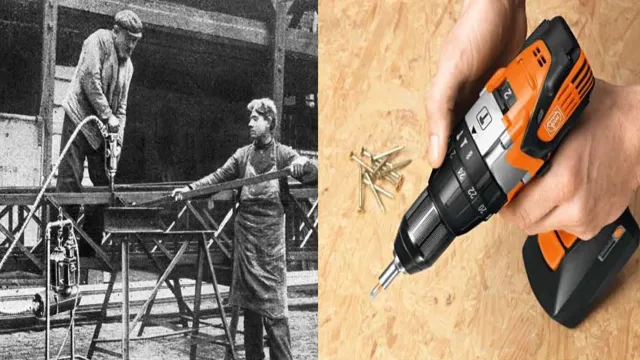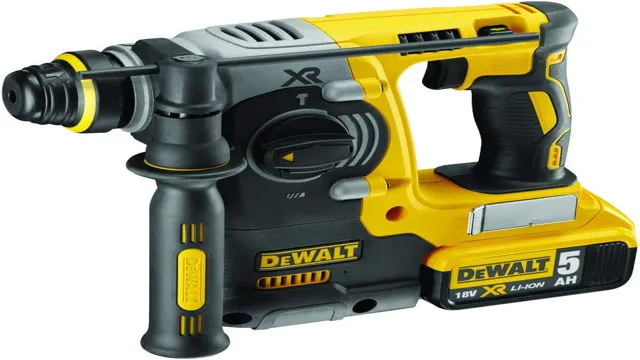When Were Cordless Drills Invented: A Brief History of Wireless Power Tools

Imagine working on a construction site or DIY project and having to rely solely on a manual drill to get the job done. The process would be time-consuming and require a considerable amount of physical effort. Fortunately, the invention of cordless drills has revolutionized the way we approach home improvements and construction tasks.
Cordless drills are now commonly used in various industries, but have you ever wondered about their origins? Who invented them, and how did they come to be? In this blog, we will discuss the fascinating history of cordless drills, taking you through their evolution from early beginnings to the modern-day versions we know and love.
Early Power Drills
Cordless drills have been revolutionizing the construction industry for decades. But when were cordless drills invented? Believe it or not, the earliest power drills date back to the 19th century. The first electric drill was developed by Arthur James Arnot in 1889 in Melbourne, Australia.
However, the drill was very heavy and could only be used when plugged in. In the early 20th century, hand-held drills that used electric power became commercially available. Bosch, an engineering firm based in Germany, was one of the first companies to produce portable electric drills.
In the 1960s, the cordless drill was invented and became popular with construction workers, DIY enthusiasts, and home renovators. Today, countless manufacturers produce different models of cordless drills with varying features and price ranges to cater to the needs of the multitude desiring the best quality power drills. No wonder it’s an essential tool in every toolbox!
Early 20th Century Innovations
Early power drills were one of the most significant innovations of the early 20th century. Before power drills, workers used hand-cranked drills, which were slow, labor-intensive, and limited. Power drills revolutionized the drilling process, allowing workers to drill faster and with more precision and power.
The power drills were typically powered by electric motors and could drill through materials such as metal, wood, and concrete with ease. As a result, industries such as construction, manufacturing, and woodworking were able to become more efficient and productive with the introduction of power drills. Today, power drills continue to be a staple of the modern workplace, and their impact on industry and productivity cannot be understated.

Introduction of Portable Power Tools
Portable power tools have revolutionized the way we approach woodworking, DIY, and construction projects. But did you know that the power drill, one of the most commonly used power tools, has been around for over a century? Early versions of the power drill were bulky and cumbersome, requiring two people to operate. In 1895, German engineer Wilhelm Emil Fein developed the first electric hand drill, which weighed in at a whopping 16 pounds and required a team of six men to move it around.
It wasn’t until the mid-20th century that power drills became more compact and affordable, making them more widely accessible to the general public. Nowadays, power drills are versatile, efficient, and come in all shapes and sizes, allowing DIY enthusiasts and professionals alike to tackle even the most challenging drilling tasks. With the advent of cordless technology, drills are even more portable, making them ideal for use on the go or in tight spaces.
It’s incredible to think how far power drills have come in such a short time, and it’s exciting to think about what the future holds for these invaluable tools.
The Rise of Cordless Drills
Cordless drills have revolutionized the way we approach DIY and construction projects today, but when were cordless drills actually invented? Believe it or not, the first cordless drill was invented by Black & Decker in 1961 and was powered by nickel-cadmium batteries. However, it wasn’t until the mid-1980s that these drills became more widely available to consumers and began to gain popularity. One of the major benefits of the cordless drill is its convenience and portability, allowing users to move freely around job sites without having to worry about cords or power outlets.
With improvements in technology, newer cordless drills can pack even more power into a compact and lightweight design, making them the go-to tool for many contractors and DIYers alike. So, the next time you use a cordless drill, remember that it wasn’t always this easy, and be grateful for the advancements in technology that have made our lives more convenient in countless ways.
The Birth of the Cordless Drill
Cordless drills have become a staple in the toolbox of every DIY enthusiast and professional handyman, but they weren’t always so convenient. The birth of the cordless drill can be traced back to the 1960s when Black & Decker introduced the first cordless power drill that used rechargeable batteries. However, it wasn’t until the 1980s that cordless drills became more widely available as they became smaller, lighter, and more affordable.
These advancements made cordless drills a popular choice for both homeowners and professionals who needed a tool that was easy to maneuver in tight spaces. Today, cordless drills have even surpassed their corded counterparts in terms of power and versatility. With technologies such as brushless motors and lithium-ion batteries, cordless drills can handle almost any task.
Plus, they offer the convenience of being portable, allowing you to tackle projects anywhere without being tethered to an electrical outlet. Whether you’re a DIY enthusiast or a seasoned professional, a cordless drill is an essential tool that you can’t go wrong with.
You May Also Love:
Technological Advancements in the 1960s
The 1960s saw many technological advancements that revolutionized the way we do things today. One of the most important innovations of the era was the rise of cordless drills. Before cordless drills, people were limited by cords and had to be near a power source to use their drill.
This was a huge inconvenience and often prevented people from working in certain areas or completing projects efficiently. The cordless drill, with its rechargeable battery, allowed workers to use their drill almost anywhere without having to worry about being tethered to an outlet. This was a game changer for construction workers, agriculture laborers, and DIY enthusiasts.
With the cordless drill, they could work more quickly and easily, even in remote locations. Today, cordless drills are ubiquitous and have become an essential tool for anyone who works with their hands. They have come a long way since their inception in the 1960s and continue to improve year after year.
Improvements in the 1980s
During the 1980s, many improvements were made in the realm of power tools, and one of the most significant advances was the rise of cordless drills. Prior to this, drills were tethered to electrical sockets, severely limiting their use and portability. However, with the introduction of cordless drills, contractors and DIY enthusiasts alike were able to work more efficiently, with greater flexibility and range of movement.
These drills were also easier to handle than their bulky predecessors, with lighter weights and streamlined designs that enabled users to work in tight spaces. The power of cordless drills increased as well, with better battery technology allowing them to perform heavy-duty tasks that were once only possible with corded drills. As a result, cordless drills became an essential tool for professionals and hobbyists alike, and they remain a popular and indispensable tool to this day.
Advancements of Cordless Drills Today
Cordless drills have revolutionized the way we work on DIY projects or professional woodworking and construction. These versatile tools are incredibly convenient since they no longer rely on electric cords to operate. So, when were cordless drills invented? The first cordless drill was patented in the mid-20th century by Black & Decker.
However, the technology of these early models was not as efficient as modern cordless drills. With the advancements of battery technology and the introduction of lithium-ion batteries, cordless drills have become more powerful, lightweight, and longer-lasting. Today, cordless drills feature innovative design elements, such as brushless motors, which increase performance and efficiency.
Additionally, some models have smart features like automatic speed adjustment, torque control, and LED lighting, making work even easier. Overall, cordless drills have come a long way since their conception, and we can expect even more advancements in the near future.
Modern Lithium Ion Technology
When it comes to cordless drills, we’ve come a long way since the early days. Thanks to modern lithium-ion technology, these tools are now more efficient, powerful, and long-lasting than ever before. One of the most significant advancements in cordless drills today is the use of lithium-ion batteries, which offer higher energy density than their older, nickel-cadmium counterparts.
This means you can use your drill for longer periods, with less need for recharging. Lithium-ion batteries are also more lightweight, which makes them easier to handle and less tiring to use. Additionally, modern cordless drills now have smarter features like auto-stop functions, which prevent overloading and extend the lifespan of your tool.
With these advancements, it’s no wonder that cordless drills are now the go-to choice for DIYers and professionals alike.
Changing Features
Cordless drills have come a long way and have advanced in many ways over the years. One significant change in features is their battery life. In the past, cordless drills only lasted for a short amount of time, and constant charging was needed.
However, with advancements in battery technology, you can now find cordless drills with battery life of up to 12 hours or more. Another feature that has changed is the power output of cordless drills. Nowadays, cordless drills provide enough power to complete demanding tasks, which were once only possible with corded drills.
Additionally, modern cordless drills are more lightweight and ergonomically designed for easy handling, reducing strain on the hands and making them more comfortable to use for extended periods. Finally, manufacturers today have developed drills with LED lights, which illuminate the work area, giving better visibility and making it easier to work in dimly lit areas. These advancements have made cordless drills not only convenient but also efficient, making them an essential tool for both professionals and DIY enthusiasts.
Conclusion
So, when were cordless drills invented? Well, it turns out that the history of cordless drills is a bit of a twisty, turny tale. The first cordless drill was actually invented back in the 1960s, but it wasn’t until the 1980s that cordless drills really started to take off. Today, cordless drills are an essential tool for every DIY enthusiast, and they continue to evolve and improve year after year.
From powering through brick walls to delicately screwing in tiny screws, the cordless drill has come a long way – and we can’t wait to see what the future holds!”
FAQs
Who invented cordless drills?
The first cordless drill was invented by Black & Decker in 1961.
What was the first cordless drill called?
The first cordless drill was called the “Pistol Grip Cordless Drill”.
What is the most popular brand of cordless drill?
Many brands make cordless drills, but currently, DeWalt is one of the most popular brands.
How long does a cordless drill battery last?
The battery life of a cordless drill varies depending on the brand and usage, but typically, a fully charged battery can last anywhere from 30 minutes to several hours.
Are cordless drills more expensive than corded drills?
Cordless drills are generally more expensive than corded drills because they require a battery and charger, which adds to the production cost.
Can cordless drills be used for heavy-duty projects?
Yes, cordless drills can be used for heavy-duty projects. However, some cordless models may not be as powerful as corded drills.
How has technology improved cordless drills over the years?
Technology has improved cordless drills by making them more powerful, lightweight, and compact, with improved battery life and faster charging times.



